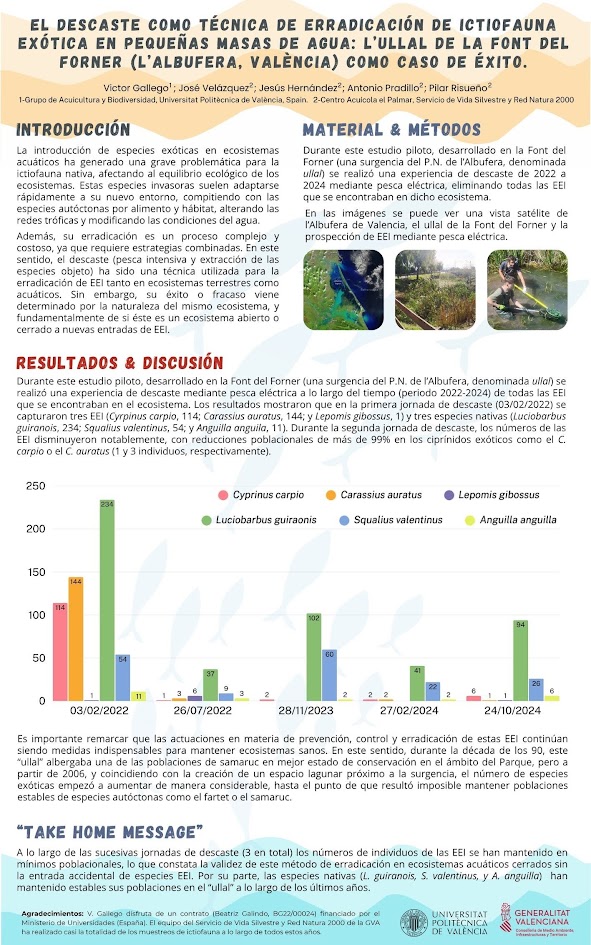Entre el 22 y el 25 de septiembre
se ha celebrado en el Palacio de Congresos de Valencia el congreso anual de la European Aquaculture Society, Aquaculture
Europe 2025, con la participación de 3115 asistentes de 97 países, y 155 empresas que mostraron en los stands
de la zona comercial todo tipo de productos y avances para el sector acuícola. Se presentaron 1254 resúmenes científicos (597 cominicaciones orales y 571 e-posters) en 57 sesiones temáticas.
Personalmente, he tenido la ocasión
de participar como miembro del Steering
Committee representando a la Universitat Politècnica de València, y de actuar
como Chair en la sesión Reproduction & broodstock management –
Freshwater.
La Dra. Luz Pérez se encargó de preparar los dípticos con información
sobre el Máster Universitario
en Acuicultura y que se distribuyó en el stand del que dispusimos CSIC y
las universidades de la ciudad de Valencia.

El miércoles 24 tuvo lugar la
sesión titulada:
THINKINAZUL – Multidisciplinary
Research Program of Excellence, en la que se hizo un repaso de los retos,
resultados y perspectivas de los diferentes
Workpackages
del
Proyecto.
Asistieron representantes de las distintas universidades implicadas y de la
Generalitat Valenciana. En el caso del WP2,
Reproducción
y Genética, en el que participamos desde la UPV, los encargados de exponer
fueron nuestros colegas los Drs. Ana Gómez (IATS, CSIC) y Paulino Martínez
(Universidad de Santiago de Compostela).
Nuestra principal participación
científica fue durante la sesión
Reproduction
& broodstock management – Marine, durante la que presentamos 4 comunicaciones
orales (todas ellas pueden encontrarse en el
Book
of Abstracts) a cargo de Fátima Fernández, del Dr. Thales França (quien
tuvo dos presentaciones), y de nuestra colega la Dra. Cinta Zapater (IATS,
CSIC):

TRPV channels in testes and
sperm: describing the physiological effects of raising water temperatures in
the European sea bass (Dicentrarchus labrax). F. Fernández-García, T.S.
França, S. Sarih, C. Zapater, A. Felip, M. Morini, J.F. Asturiano

Biodegradable containers as
alternative for fish sperm cryopreservation. T.S. França, E.A. Sanches,
N.S. Teixeira, J.L. Benato, W.A. González-López, M.P. Sanchez, L. Ferrão, F.
Fernández-García, L.P. Borges, A. Belenguer, P.G. Holhorea, J.C. Calduch-Giner,
A. Felip, A. Gómez, J. Pérez-Sánchez, D. P. Streit Jr., J.F. Asturiano
Development of challenge tests to
select sperm samples from Mediterranean fishes being resilient to climate
change. T.S. França, W.A. González-López, F. Fernández-García, A.
Belenguer, P.G. Holhorea, J.C. Calduch-Giner, A. Felip, E. Mañanós, N. Ducan,
A. Gómez, J. Pérez-Sánchez, L. Pérez, J.F. Asturiano
Gonadotropin plasmid gene therapy
triggers gametogenesis in male and female European eel (Anguilla anguilla).
C. Cruz-Castellón, C. Zapater, M. Morini, T.S. França, L. Pérez, J.F.
Asturiano, A. Gómez
Nuestras compañeras Yáiza
Fernández Jorreto y Fátima Fernández García formaron parte del grupo de estudiantes
que colaboraron en diversas tareas de apoyo durante los días del congreso.
Gracias a todos ellos.




.jpeg)
.jpeg)































.JPG)


.jpeg)












